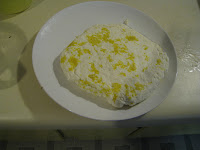Paneer (or panir) is an Indian cheese used in many delectable dishes, including my favorite brussels sprouts dish EVER that I promise to post about on here at some point. Queso blanco appears to be the Latin American equivalent, with the distinction that according to some cheese-making books queso blanco uses vinegar as the acid to curdle the milk and paneer uses fresh lemon juice.
Regardless, we set off on our adventure with 3 gallons of milk (2 of homo, 1 organic homo). We also ended up testing to styles of making the cheese. Things you must have to do this: a good thick bottomed pot, cheese cloth, a strainer, and something like a pizza pan with holes in the bottom. Other than that, this is one of the easiest things I have attempted in the kitchen.
Version 1: We followed one recipe using 8 c. milk, 1/2 c. water, and 1/4 c. lemon juice. Bring milk and water to a boil. When the milk has foamed up about 3 inches high, immediately remove from heat and pour lemon juice in a swirl pattern so that the juice is evenly distributed. Did not stir. Let sit for 10 min and then pour into cheesecloth in colander. Let sit for 15 min or so and then fold the edges of the cheesecloth over and shape the curds into a rough circle or square shape. Put on a pan with holes (we used a pizza tray), and place a heavy saucepan on top to squeeze more water out of the cheese. Leave for 30 - 60 min (depends how dry you like your cheese). Result: formed a solid wheel of paneer, very refreshing and mild tasting. Excellent in wedges on fresh naan spread with tamarind chutney. Or sprinkled with lemon zest and drizzled with honey. Or just by itself!
 |
| Curds and whey separated |
 |
| Straining curds in the cheesecloth |
 |
| Mini-wheel of paneer! |
Version 2: Same recipe, different technique. This time we stirred continuously and just when the milk had come to a boil (almost no foam), we removed from the heat, stirred vigorously to get a little vortex going, poured in the lemon juice and gave it a good couple of stirs after. Not sure if there was much difference, but there seemed to be a little less scalding of milk on the bottom of the pan.
Version 3: Instead of lemon juice, we used apple cider vinegar and scaled it up to a whole gallon at once. We also used a different method of separating the curds from whey: gently ladle curds out using a slotted spoon into the cheesecloth - I think this produced a more cohesive cheese. Both friend and myself liked the taste of the vinegar curdled cheese better. From my class notes, I had a recommendation of half malt vinegar/half apple cider vinegar for best taste, but I had already bought milk so that was as much as I was willing to purchase for this project :)
We then took half the curds and added cumin seeds, lemon salt and black pepper, and lemon salt to the remainder. Good with salt. It seemed that stirring or knead the spices in may mean the curds do not all stick together as well when pressed.
Our favorite cheeses (though we haven't tasted them), when scooping the curd out, we layered the curds with fresh lemon zest and salt! It also looks beautiful. We then went a little wild at the end and used raspberry wine vinegar as the curdling agent for the last batch, producing a delicately pink tinted cheese, nicknamed "the princess cheese".
 |
| Lemon zest and lemon salt cheese |
Next time: cheese with bacteria and rennet!


Yay paneer!
ReplyDelete